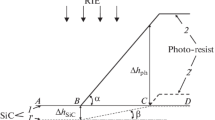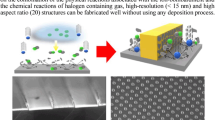Abstract
We have carried out a series of experiments aimed at producing arrays of mesas on both Si(001) and Si(111) which are free from atomic steps. These are of interest in CMOS technology and for quantum well structures. They also provide interesting substrates for fundamental surface science experiments. In previous work we have created atomically flat regions surrounded by ridges through an evaporation method. The present work ‘inverts’ the previous process by using a pattern of trenches to define the mesas and then depositing Si to grow the atomic steps off the edges. The mesas are created on Si wafers, which are ~1° from the (111) and (001) plane by lithography and reactive ion etching. Step-free mesas were formed on Si(111) but not yet on Si(001). Both the evaporation and this new growth technique rely on step flow to move the steps to the edges of the flat areas. Although the evaporation method is simpler, an advantage of the growth technique is that it can be carried out at lower temperature. The maximum size of mesa that can be made free of atomic steps depends on the combination of temperature and deposition rate. On very large step-free terraces nucleation of islands and concentric arrays of mono-atomic steps are observed; these correspond to the vacancy pits observed with the evaporation method.
Similar content being viewed by others
References
S. Tanaka, C.C. Umbach, J.M. Blakely, R.M. Tromp, and M. Mankos, Appl. Phys. Lett. 69, 1235 (1996).
Doohan Lee, and Jack Blakely, Surf.Sci. 445, 32 (2000).
T. Ogino, H. Hibino, and Y. Homma, Appl. Surf. Sci. 117/118, 642 (1997).
Toshio Nishida, and Naoki Kobayashi, Appl. Phys. Lett. 69, 2549 (1996).
S.E. Roadman, N. Maity, J.N. Carter, and J.R. Engstrom, J. Vac. Sci. Technol. A 16, 3432 (1998).
A.V. Latyshev, A.B. Krasilnikov, and A.L. Aseev, Phys. Rev. B. 54, 2586 (1996).
T. Irisawa, Y. Arima, and T. Kuroda, J. Cryst. Growth. 99, 491 (1990).
Doohan Lee, Todd Schroeder, James Engstrom and Jack Blakely, Appl. Phys. Lett. 78, 1349 (2001).
V.A. Zinovyev, V.Y. Balandin, L.N. Aleksandrov, and A.V. Dvurechenskii, Phys. Stat. Sol. (b). 173, K5 (1992).
Author information
Authors and Affiliations
Rights and permissions
About this article
Cite this article
Lee, D., Schroeder, T., Engstrom, J. et al. A Growth Technique to Make Extensive Atomically Flat Silicon Surfaces. MRS Online Proceedings Library 648, 1011 (2000). https://doi.org/10.1557/PROC-648-P10.11
Published:
DOI: https://doi.org/10.1557/PROC-648-P10.11




